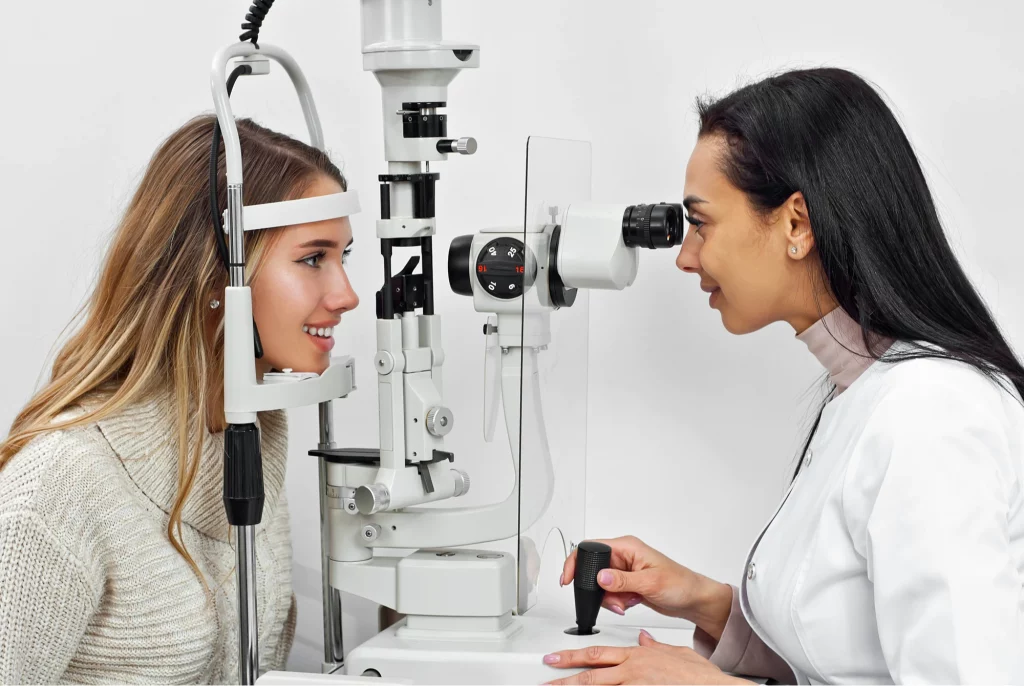Medically Reviewed by: Nicholas P. Bell, M.D.
What Are The Early Symptoms of Glaucoma?
Glaucoma is a serious eye condition that can lead to vision loss and blindness. Because early detection and treatment can be the difference between preserving and losing your vision, it is essential to know the early symptoms of glaucoma.
The first signs of glaucoma that you should be aware of include eye pain or discomfort, headaches, nausea or vomiting, halos around lights, and sudden onset of visual field loss. If you experience any of these symptoms, you should see an eye doctor as soon as possible for an evaluation.
What are the first signs that glaucoma is developing?
There are two main types of glaucoma — open angle and closed angle — and symptoms will depend on which type you have. How early can glaucoma start? Glaucoma can start at any age but is most common in adults over the age of 60. It is also more likely to develop if it runs in your family.
If you have symptoms of high eye pressure, but no other early symptoms of glaucoma, you may believe it is unnecessary to have it checked. However, if left untreated, high eye pressure can lead to glaucoma. This is why it’s important to have regular eye exams so that your doctor can check the pressure inside your eyes and look for early signs of glaucoma.
Please note that the doctors at Eye Center of Texas do not perform routine eye examinations. We encourage our patients to visit our partner Optometrists, available on our recommended optometrists page.
Symptoms of open-angle glaucoma
This is the most common type of glaucoma and typically has no early symptoms. As the disease progresses, you may start to experience visual field loss. This means you will gradually lose your peripheral vision to see objects to the side.
If this type of glaucoma is not detected early, it can lead to total blindness, making your annual eye exams even more important. During a comprehensive eye exam, your doctor will check for early signs of glaucoma and measure the pressure inside your eyes. This is done with a tool called a tonometer. If glaucoma is suspected, your doctor may perform additional tests to confirm the diagnosis.
Symptoms of closed-angle glaucoma
This type of glaucoma is less common but can be more severe because it can develop quickly and cause a sudden increase in eye pressure. Closed-angle glaucoma can cause symptoms such as:
- Eye pain or redness
- Severe headaches
- Nausea and vomiting
- Sudden onset of visual field loss
- Blurred vision
Closed-angle glaucoma is classified as a medical emergency. If you experience any of these symptoms, you should see an eye doctor immediately to ask about your glaucoma symptoms and treatment. Because there is some overlap in symptoms between cataracts vs. glaucoma, it’s important to get a diagnosis quickly since glaucoma can cause long-term damage to the optic nerve.
Symptoms of glaucoma in children
Pediatric glaucoma can develop in children and infants, but it is much less common. Glaucoma in children can be a result of chronic steroid use, trauma, an underlying medical condition, or a genetic factor such as family history. The early symptoms of glaucoma in children can be different from those in adults and may include:
- Eye pain or discomfort
- Headaches
- Nausea or vomiting
- Tears without crying
- Halos around lights
- Sensitivity to light
- Sudden onset of visual field loss
- Dull or cloudy eyes
If you notice any of these symptoms in your child, it’s important to see an eye doctor right away for an evaluation.
Is glaucoma hereditary?
Glaucoma can run in families, so if you have a family member with glaucoma, you may be at increased risk. Be sure to tell your eye doctor if you have a family history of glaucoma. Regular comprehensive eye exams are the best way to detect glaucoma early so that treatment can be started to help preserve your vision.
What causes glaucoma?
Although genetics play a large role in your likelihood of developing glaucoma, there are other factors to consider, including:
- Eye injuries or trauma
- Certain medical conditions such as diabetes or high blood pressure
- Use of steroids, either in the form of eye drops or systemic steroids
- Previous eye surgery
- Cigarette smoking
- High blood pressure
- Diabetes
Glaucoma treatment options
If you have been diagnosed with glaucoma, there are several treatment options available to help slow the progression of the disease and preserve your vision. These include:
- Eyedrops: Several different types of eyedrops can be used to treat glaucoma. These help to lower the pressure inside your eye by either decreasing the amount of fluid produced or increasing the outflow of fluid from your eye.
- Oral medications: Your doctor may also prescribe oral medications to help lower the pressure inside your eye. These work by decreasing the amount of fluid produced or increasing the outflow of fluid from your eye.
- Laser surgery: The Selective Laser Trabeculoplasty, or SLT laser procedure, is non-destructive and can be used to improve the outflow of fluid from your eye and help lower the pressure inside your eye.
- Filtration surgery: If glaucoma has caused damage to your optic nerve, surgery may be necessary to help preserve your vision.
If you have any questions about glaucoma symptoms and treatment, be sure to talk to your eye doctor. They will be able to help you develop a treatment plan that is right for you, as well as discuss what to expect after glaucoma surgery if that is the avenue you decide to take.
Concerned about potential early symptoms of glaucoma? Call Eye Center of Texas today!
If you have any concerns about your vision or are experiencing any early symptoms of glaucoma, don’t hesitate to contact us at Eye Center of Texas. Our team of specialized ophthalmologists, including our glaucoma specialists Mark L. Mayo, M.D. and Nicholas P. Bell, M.D., are experienced in diagnosing glaucoma symptoms and treatment. We will work with you to develop a treatment plan that is right for you to help you preserve your vision for the years ahead.
Call us today at 713-797-1010 to schedule your visit or request an appointment online.
More Helpful Articles by Eye Center of Texas:
- What You Need To Know About Laser Eye Surgery Dry Eyes
- ICL Eye Surgery Recovery Time
- What Are The Three Types of Cataracts?
- How to Relieve Contact Lens Intolerance
- EVO Visian ICL: The Latest in Refractive Surgery
Related Articles
Financing Options Available
Apply today to find a financing option that meets your needs.
Our Locations
Houston/Bellaire
6565 W. Loop S., Suite 650Bellaire, TX 77401
Medical Office:
713-797-1010
Medical Fax:
713-357-7276
LASIK/Near Vision:
Office: 713-395-1515
Fax: 713-357-7278
Pasadena
4415 Crenshaw RoadPasadena, TX 77504
Medical Office:
281-977-8800
Medical Fax:
281-977-8877
Sugar Land
15200 S.W. Freeway, Suite 130Sugar Land, TX 77478
Medical Office:
281-277-1010
Medical Fax:
281-277-4504
Clear Lake
455 E. Medical Center Blvd., Suite 110Webster, TX 77598
Medical Office:
281-332-1397
Medical Fax:
281-282-9152
Katy
Greenhouse Medical Plaza2051 Greenhouse Road, Suite 110
Houston, TX 77084
Medical Office:
346-547-7070
Medical Fax:
281-214-2971
The Woodlands/Conroe
100 Medical Center Blvd., Suite 118Conroe, TX 77304
Medical Office:
936-647-1610
Medical Fax:
936-647-1620


